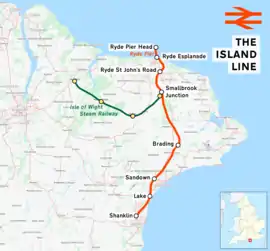Island Line, Isle of Wight
The Island Line is a temporarily-closed railway line on the Isle of Wight that links Ryde Pier Head with Shanklin on the Island's east coast. The line was electrified (630 V DC third rail) in 1967[1][2] and a planned 3-month closure for further refurbishment began in January 2021. Trains connect with passenger ferries to Portsmouth Harbour at Ryde Pier Head, and these ferries in turn connect with the rest of the National Rail network via the Portsmouth Direct Line. The line also connects to the Isle of Wight Steam Railway, a steam-operated heritage railway, at Smallbrook Junction. For much of its length the line runs alongside the A3055, criss-crossing this road by means of the Ryde Tunnel and bridges at Rowborough, Morton Common, Lake Hill and Littlestairs.
| Island Line | |||
|---|---|---|---|
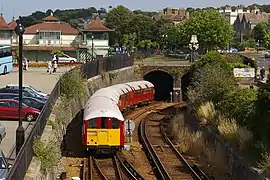 A pair of Island Line Class 483s in London Underground livery entering the Ryde tunnel. | |||
| Overview | |||
| Status | closed for rebuilding | ||
| Owner | Network Rail | ||
| Locale | Isle of Wight | ||
| Termini | Ryde Pier Head 50.7385°N 1.1604°W Shanklin 50.6338°N 1.1798°W | ||
| Service | |||
| Type | Community railway | ||
| Operator(s) | Island Line | ||
| Depot(s) | Ryde depot | ||
| Rolling stock | British Rail Class 484 | ||
| History | |||
| Planned opening | 1 April 2021 | ||
| Opened | 5 April 1880 | ||
| Closed | 3 January 2021 | ||
| Technical | |||
| Line length | 8 1⁄2 miles (13.7 km) | ||
| Number of tracks | Mixture of single and double track | ||
| Character | Fully grade separated except foot crossings | ||
| Track gauge | 4 ft 8 1⁄2 in (1,435 mm) standard gauge | ||
| Electrification | 630V DC third rail (1967-2020) 750 V DC third rail (2021-) | ||
| Operating speed | 45 mph (72.4 km/h) | ||
| |||
Route
Island Line, Isle of Wight | ||||||||||||||||||||||||||||||||||||||||||||||||||||||||||||||||||||||||||||||||||||||||||||||||||||||||||||||||||||||||||||||||||||||||||||||||||||||||||||||||||||||||||||||||||||||||||||||||||||||||
|---|---|---|---|---|---|---|---|---|---|---|---|---|---|---|---|---|---|---|---|---|---|---|---|---|---|---|---|---|---|---|---|---|---|---|---|---|---|---|---|---|---|---|---|---|---|---|---|---|---|---|---|---|---|---|---|---|---|---|---|---|---|---|---|---|---|---|---|---|---|---|---|---|---|---|---|---|---|---|---|---|---|---|---|---|---|---|---|---|---|---|---|---|---|---|---|---|---|---|---|---|---|---|---|---|---|---|---|---|---|---|---|---|---|---|---|---|---|---|---|---|---|---|---|---|---|---|---|---|---|---|---|---|---|---|---|---|---|---|---|---|---|---|---|---|---|---|---|---|---|---|---|---|---|---|---|---|---|---|---|---|---|---|---|---|---|---|---|---|---|---|---|---|---|---|---|---|---|---|---|---|---|---|---|---|---|---|---|---|---|---|---|---|---|---|---|---|---|---|---|---|
| ||||||||||||||||||||||||||||||||||||||||||||||||||||||||||||||||||||||||||||||||||||||||||||||||||||||||||||||||||||||||||||||||||||||||||||||||||||||||||||||||||||||||||||||||||||||||||||||||||||||||
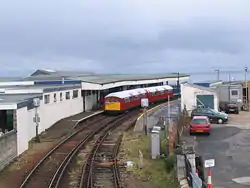
The line starts at Ryde Pier Head station,[lower-alpha 1] which is located at the sea end of Ryde Pier and connects with cross−Solent ferry services to/from Portsmouth Harbour operated by Wightlink. The station has an island platform with two platform faces and two tracks,[3] although only the western track (and thus only one platform face) remains in passenger use. From here, the line runs along the pier's eastern side towards the shore before reaching Ryde Esplanade station[lower-alpha 2] at the other end of the pier. Located north of Ryde's town centre, Esplanade station is the busiest of the three stations in the town;[4] it forms part of the town's main transport interchange along with the nearby Ryde Bus Station (offering bus services to the rest of the island)[5] and Ryde Hoverport (with cross−Solent hovercraft connections to and from Southsea).[6] The station has one side platform in operation; a second platform lies adjacent to the disused track, albeit in a decaying state.
Although the line along the pier appears to be a typical double-track line (with one track out of use), there is no crossover between the two tracks until immediately south of Esplanade station, meaning they are de facto two separate single-track lines[3] (a layout similar to those at Bare Lane,[7] Glenrothes with Thornton[8] and Worcester Foregate Street[9] stations).
After the crossover just south of Esplanade station, both tracks are operational. The line continues as double-track through Ryde via the Ryde Tunnel, bypassing the town centre to the northeast, before it reaches Ryde St John's Road station[lower-alpha 3] to the east of the town centre. The station has a total three platforms[3] linked by a footbridge, two of which are in regular use by passenger services. The third platform, while open, is a south-facing bay platform,[3] meaning only the few terminating services can stop there. Adjacent to St John's Road station is Ryde depot − the only traction maintenance depot on the line.
The line then leaves Ryde and continues southwards, reducing to single-track immediately north of the next station, Smallbrook Junction.[lower-alpha 4] This station is unique on the National Rail network in that there is no public access into or out of the station − it exists purely as an interchange between the Island Line and the Isle of Wight Steam Railway.[10][11] The station was built in 1991 − the same year that the steam railway was extended to this location. Despite the station's name there is no longer an actual junction here, as the two railway lines are not physically connected to each other.[3]
The next station on the line is Brading.[lower-alpha 5] Until 1988 there was a passing loop at the station; the second track has since been lifted, although the second platform and the footbridge between the two platforms are still in place. The passing loop is scheduled to be restored in 2021 (see 2020−21 upgrade work below). The line then continues in a southwesterly direction towards Sandown station,[lower-alpha 6] which has retained its passing loop;[3] the station's two platforms are connected by a subway.
Beyond Sandown, the line is single-track for the remainder of the route.[3] The penultimate station on the line is Lake,[lower-alpha 7] opened in 1987, and the line terminates just over a mile later at Shanklin station.[lower-alpha 8] Shanklin also used to have a second platform, which is now used as a flowerbed. Until 1966, the line continued further south to Wroxall and Ventnor (see History below).
The full line, from Ryde Pier Head to Shanklin, is 8 miles 31 chains (13.5 km) long.[3]
Services
The typical weekday, Saturday and Sunday service pattern on the line consists of two trains per hour each way between Ryde Pier Head and Shanklin, calling at all intermediate stations except (usually) Smallbrook Junction.[12] Due to the location of the two passing loops on the line (at Ryde St John's Road and Sandown), trains cannot run at even 30-minute intervals; instead, services run at alternating intervals of approximately 20 and 40 minutes. The frequency drops to one train per hour during the evenings.[12]
Smallbrook Junction station is only open on days when the Isle of Wight Steam Railway is operating; when open, the station is served by up to 9 trains per day in each direction between 10:30 and 17:00.[12]
Passenger numbers
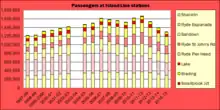
After privatisation, passenger numbers rose steadily from an estimated 1.21 million in 1997–98 to an estimated 1.61 million in 2006–07.[4]
After the merger of the Island Line and South West Trains franchises in 2007, Island Line passenger numbers fell slightly from an estimated 1.61 million in 2006–07 to an estimated 1.53 million in 2009–10. They peaked again at an estimated record 1.67 million in 2011–12, but since then fell to an estimated 1.31 million in 2014–15. This was the lowest annual estimate since 1998–99, and suggests passenger numbers fell by 22% in four years.[4]
| Station usage | |||||||||||||||||
|---|---|---|---|---|---|---|---|---|---|---|---|---|---|---|---|---|---|
| Station name | 2002–03 | 2004–05 | 2005–06 | 2006–07 | 2007–08 | 2008–09 | 2009–10 | 2010–11 | 2011–12 | 2012–13 | 2013–14 | 2014–15 | 2015–16 | 2016–17 | 2017–18 | 2018–19 | 2019–20 |
| Ryde Pier Head | 116,652 | 121,387 | 116,812 | 149,226 | 193,714 | 210,604 | 210,604 | 235,156 | 223,542 | 217,272 | 209,734 | 218,060 | 218,410 | 210,006 | 211,794 | 204,154 | 181,060 |
| Ryde Esplanade | 431,636 | 453,314 | 456,944 | 489,372 | 442,861 | 396,358 | 360,650 | 392,020 | 364,780 | 328,366 | 301,660 | 289,574 | 281,344 | 277,176 | 258,784 | 247,152 | 220,384 |
| Ryde St John's Road | 140,242 | 160,891 | 175,208 | 178,869 | 178,914 | 190,796 | 200,976 | 240,046 | 251,694 | 229,450 | 202,188 | 184,924 | 180,220 | 179,822 | 156,850 | 132,174 | 116,138 |
| Smallbrook Junction | 2,995 | 3,087 | 2,716 | 2,965 | 4,363 | 9,672 | 10,170 | 11,472 | 11,478 | 10,832 | 11,408 | 11,230 | 12,134 | 12,768 | 12,670 | 12,920 | 12,352 |
| Brading | 73,546 | 66,932 | 69,074 | 68,841 | 60,680 | 65,794 | 61,406 | 63,872 | 67,840 | 60,540 | 55,594 | 50,954 | 43,846 | 48,500 | 45,848 | 42,170 | 32,842 |
| Sandown | 244,876 | 242,564 | 254,040 | 265,499 | 264,784 | 264,126 | 256,890 | 271,282 | 297,722 | 273,118 | 240,766 | 203,143 | 194,276 | 183,488 | 162,310 | 150,748 | 123,126 |
| Lake | 78,279 | 77,995 | 76,364 | 71,465 | 69,350 | 67,162 | 67,584 | 67,656 | 77,772 | 71,566 | 61,840 | 53,006 | 42,310 | 53,786 | 47,602 | 43,236 | 37,574 |
| Shanklin | 329,887 | 341,826 | 345,020 | 382,842 | 368,776 | 358,658 | 338,612 | 345,844 | 373,006 | 352,134 | 318,410 | 294,698 | 293,654 | 291,346 | 275,076 | 260,016 | 226,746 |
| The annual passenger usage is based on sales of tickets in stated financial years from Office of Rail and Road estimates of station usage. The statistics are for passengers arriving and departing from each station and cover twelve month periods that start in April. Methodology may vary year on year. Barking and Blackhorse Road are affected by usage of the ticket gates for the underground and that Gospel Oak connects to the North London Line section of the London Overground and is similarly affected. Barking is further affected by the ticket gates used to access C2C services. | |||||||||||||||||
History
The line from Ryde St John's Road to Shanklin was opened on 23 August 1864, having been built by the Isle of Wight Railway. In 1866 the line was extended through to Ventnor. The line was originally built as single track throughout, with passing loops provided at Brading, Sandown and Shanklin stations.
In 1880 the London and South Western Railway (LSWR) and London, Brighton and South Coast Railway (LBSCR) opened a jointly-owned line north from Ryde St John's Road. Under the direction of LBSCR Chief Engineer Frederick Banister,[13] the building of the extension included a new tunnel and a third Ryde Pier to enable the line to reach Ryde Pier Head, which provided a connection with the companies' ferry services. When the LBSC/LSWR joint line opened, it was as a double track section from Ryde St John's Road station through to Ryde Pier Head. There was a scissors crossover situated on Ryde Pier to allow trains to access all platforms. Sets of crossovers were installed at St John's Road to enable trains to change from the joint line's left-hand running to the single-track sections on the Isle of Wight Central Railway's Newport line and the Isle of Wight Railway's Shanklin line (now known as the Island Line).[14]
Southern Railway
Following the Railways Act 1921, the Island Line and the other railways on the Isle of Wight became part of the Southern Railway. In 1926, crossovers and a signalbox were installed at Smallbrook Junction to extend double track operation from St John's Road. However, the signalbox was used only in the summer when traffic levels were high. In winter, the two lines from Smallbrook to St. John's Road reverted to independent single track operation.[14]
In 1927,[14] the passing loops at Brading and Sandown were connected to form a second section of double track.
British Rail (1948–96)
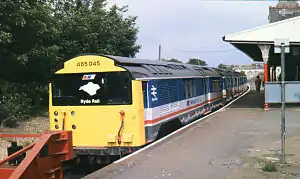
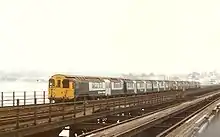
In 1948, the Southern Railway was nationalised, as part of British Railways, later British Rail. The line from Shanklin to Ventnor closed in April 1966. Steam trains were withdrawn from Ryde Pier on 17 September, and the whole line on 31 December 1966. While the line was closed, the trackbed in Ryde Tunnel was raised to reduce flooding and decrease gradients,[15] the rebuilding of Ryde Pier Head station was completed and Ryde Esplanade station was also substantially modified. The line reopened in March 1967 following its electrification.[16] In the 1980s, British Rail was sectorised and the line became part of the Network SouthEast sector. Services on the line were branded as Ryde Rail.
British Rail opened two new stations on the line. Lake station opened in 1987. Smallbrook Junction station opened in 1991, in co-operation with the Isle of Wight Steam Railway.
The double track between Sandown and Brading, along with the Brading passing loop, were removed in 1988. In 1989 the passenger service was branded as Island Line for the first time, as the name and logo was included on the "new" Class 483 trains' livery. However, this rebranding did not officially occur until 1994.[17]
Island Line franchise (1996–2007)
Following the privatisation of British Rail, the rights to run services on the line were put out to tender as a franchise. Uniquely on the National Rail network, the franchise agreement also required the successful bidder to maintain the railway line in addition to the stations and trains.[18] Stagecoach Group were announced as the winner of the franchise and from October 1996 they operated passenger services under the name Island Line Trains.
In 2002 a form of Automatic Train Protection was installed on the line. This involved the refitting of tripcocks on trains and the associated train stop trackside equipment at signals. This system is almost identical to the one originally fitted to the trains when in service on the London Underground, although it is in use only at signals protecting single-track sections of the route.[19]
The Department for Transport designated the line as a community railway in March 2006, under reforms to help boost use of rural and branch lines in the UK rail network.[20]
South West Trains franchise (2007–2017)
From February 2007 the Island Line franchise was merged with the South West Trains franchise on the mainland. Stagecoach was announced as the winner of the expanded franchise and operated Island Line as a South West Trains subsidiary.[21] However, the Island Line name was retained, styled as Island Line Trains, and was promoted as a separate division on the South West Trains website.
Island Line Trains also repainted stations in a heritage scheme of cream and green, as part of a general station improvement package.[22]
South Western Railway franchise (since 2017)
In August 2017, the franchise was taken over by South Western Railway who have maintained the brand name.[23]
Future
A number of suggestions have been made for the future of the railway, which faces long-standing issues such as the cost of maintaining Ryde Pier[24] and the increasing unreliability of the class 483 trains as they passed 80 years in service. Proposals for the route have ranged from total closure - something also explored in the 1960s[25] - to major rebuilding as light rail.
Past proposals
In the mid-1990s it was proposed to reopen the line south of Shanklin, to the original terminus at Ventnor. Despite the high costs involved, the island's MP in 2018 called for feasibility studies on this project and on the prospect of trains running between Ryde and Newport using a mix of the existing heritage railway and a rebuilt section of line between Wooton and Newport.[26]
Other proposals put forward for the future of the railway line have included converting the line to a guided busway, something considered in 2005[27] and the late 2010s as part of a consultation on the line's future.[28] The first plan for a Solent tunnel to connect the island's railways to the mainland network was authorised in the early 20th century[29] and although work to build a rail tunnel has never started, this proposal has resurfaced several times in more recent history.[30]
There have also been proposals to rebuild the line as a light rail route at several points, which would potentially allow for extension into Shanklin and other town centres,[31] the most recent being after a 2016 review of the route by transport expert Christopher Garnett commissioned by the Isle of Wight Council. It suggested converting the route with the third rail replaced with overhead lines and the remaining double-track singled with just passing loops provided. It was reported that ten T-69 trams which were built in 1999, and had previously operated on the Midland Metro, could be re-used for this scheme.[32] The Isle of Wight Council's Local Transport Plan previously mentioned that any improvements to the railway should ensure compatibility with the currently shelved South Hampshire Rapid Transit scheme. However, none of these light rail ideas have been progressed.
Other projects considered for the Island Line include flywheel or battery-powered trains, the use of Vivarail Class 230 units, as well as the transfer of 1972 and 1973 stock to the Island. Two significant considerations for any new stock are that it must pass under the tunnel at Ryde, and stop at the sharply curved platform at Ryde Esplanade railway station without fouling.[33]
The Railway Magazine reported that a meeting took place on 11 February 2015 which covered a relaxation of public railway regulation and safety standards as well as transferring the line to a Social Enterprise Company. According to RM, people present at the meeting included Claire Perry (Rail Minister), Andrew Turner MP, Nick Finney (Andrew Turner's transport advisor) and local councillors. News of the meeting has given rise to local controversy. [34]
Long-standing suggestions have included replacing the class 483 trains with newer London Transport stock which has also been retired, such as the 1972 stock and 1967 stock.[31] A plan to reinstate the passing loop at Brading was suggested in 2007–8, because Network Rail believed the line's signalling system needed replacing imminently and thought this could happen during the 2012 London Olympics.[35] In September 2019 it was confirmed that a passing loop will be installed alongside other works on track and the introduction of replacement rolling stock, allowing trains to run at even 30-minute intervals rather than a 20-minute then 40-minute gap. It is hoped that these improvements will encourage greater use.
2020−21 upgrade work
On 16 September 2019 it was confirmed that a £26m investment into the Isle of Wight's railways would mean 5 class 484 units would replace the ageing class 483s,[36] which had become unreliable to the point that services on the line had to be halved in frequency[37] for around a month.[38] The new trains are being built by Vivarail as third-rail units using D78 Stock bodyshells, and island-based stakeholders including the Isle of Wight Council and Solent Local Enterprise Partnership are contributing £1m to fund reinstatement of a long-removed passing loop at Brading to allow them to run at even half-hourly intervals.[39][36] Network Rail have also agreed to fund £5m of upgrade work on Ryde Pier to secure the line's future,[40] because failure to do so would be terminal to the line's operation.[41] The first of the Class 484 trains was originally due to arrive on the line in the summer of 2020.
Delivery of the upgrade has been delayed due to the effect of the coronavirus pandemic. In September 2019, it was expected that most of the work on the track would take place over the winter of 2020–2021, with a "shuttle" train service planned during this period.[42] Rail services were expected to be replaced by buses between Shanklin and Ryde St John's Road for 8 weeks in Autumn 2020 while the work was done, with a 4-week suspension expected between St John's Road and Ryde Pier Head.[43] However, due to delays at the manufacturer, delivery of the first of the new trains was pushed back to September 2020.[44] The work on the permanent way has also been delayed, and in August 2020 it was announced that instead of two different closure periods, with the first starting in the Autumn, the line would close completely from 4 January until 31 March 2021 for physical upgrades, including platform work and the Brading loop, with buses replacing trains between Ryde Esplanade and Shanklin, and a minibus shuttle service to connect Ryde Esplanade to Ryde Pier Head during the work.[45][46][47]
A total of 7,000 tonnes of spoil are expected to be removed during the work. A full service using only the new trains and running to an even 30-minute frequency is due to begin in May 2021.[43] Changes will be made to the track layout and signalling system, principally to introduce a new passing loop at Brading station. As the new Class 484 trains will sit higher above rail level than the Class 483s they will replace, the track through most stations will be lowered in order to prevent a large vertical difference between the train floor height and the platform height. At stations where this is not possible, platform height will instead be raised.[48] The plan as suggested in 2007-8 envisaged the passing loop at Brading replacing that at Sandown, which would have been abandoned along with the remaining double track within Ryde.[35] However, the Programme Manager from South Western Railway has publicly stated that the option of running a 20-minute service will remain after the upgrade[43] which implies that the existing passing points would remain operable.
2020 Ideas Fund
On 23 May 2020, the Department of Transport announced that approval had been given to investigate the possible reinstatement of some or all of the tracks between Shanklin and Ventnor and Ryde and Newport.[49] It was one of ten schemes across UK approved for more study under an "Ideas Fund".
Rolling stock

Due to the isolated and rural nature of the Isle of Wight's railways, rolling stock has tended to be made up from displaced older vehicles, rebuilt or modified as required. Following the work undertaken during the line's closure during the winter of 1966–67, the ceiling of Ryde Tunnel is 10 inches too low for standard National Rail vehicle types to clear.[15]
Since the reopening of the line in 1967, former London Underground Tube stock has been used. The initial trains were formed of so-called Standard Stock, made up into four and three-coach sets (with one spare vehicle, normally kept at Ryde depot), designated "4-VEC" and "3-TIS" in the British Rail Southern Region electric multiple unit classification system. (The classification letters were a pun on the Roman name for the island, Vectis, also reflected in the name of the island's nationalised bus company, Southern Vectis, which was once partially railway-owned.[50]) Under the British Railways TOPS rolling stock classification system (introduced in 1968 for locomotives and later extended to multiple unit vehicles), these units eventually became Class 485 and Class 486. The cars transferred to the island were built at various dates between 1923 and 1934, and thus maintained a somewhat unwelcome tradition of providing the island's railways with among the oldest rolling stock running anywhere on the British railway system. By 1992[51] these units had been replaced by newly refurbished London Underground 1938 Stock, designated Class 483 by British Rail. In September 2019, it was announced that the entire fleet would be replaced by Class 484 trains during 2020. The stock is maintained at Ryde St John's Road depot.
Annual season tickets
Because the Isle of Wight is within the Network SouthEast area, annual season tickets issued to and from its stations are issued as Gold Cards. A ticket from Ryde Esplanade to Ryde St Johns Road was for many years the cheapest annual ticket in the area, and even though many holders of such tickets never use them for the intended journey, the discount obtained over the year (one-third off travel during Off-Peak hours in the Gold Card area) may amply repay the cost of the ticket.[52] When the Gold Card area was extended to include the West Midlands in January 2015,[53] the Ryde ticket was undercut by a similar short-distance ticket between Lichfield City and Lichfield Trent Valley.[54]
See also
Notes
- Mileage on the line is measured from this station, starting at 0 miles 0 chains (0 km).[3]
- Mileage: 0 miles 32 chains (0.64 km)[3]
- Mileage: 1 mile 19 chains (2.0 km)[3]
- Mileage: 2 miles 17 chains (3.6 km)[3]
- Mileage: 4 miles 55 chains (7.5 km)[3]
- Mileage: 6 miles 42 chains (10.5 km)[3]
- Mileage: 7 miles 24 chains (11.7 km)[3]
- Mileage: 8 miles 29 chains (13.5 km)[3]
References
- "Southern Electric Fleet Review Summer 2004". Southern Electric Group. Archived from the original on 23 February 2013.
- "Southern Electric History and Infrastructure (Part 4)". Southern Electric Group. Archived from the original on 18 January 2016. Retrieved 5 June 2013.
- TRACKatlas of Mainland Britain (3rd ed.). Platform 5. 2017. p. 10. ISBN 978-1909431-26-3.
- Estimates of station usage − ORR Data Portal
- Timetables & Maps − Southern Vectis
- Hovertravel
- TRACKatlas of Mainland Britain (3rd ed.). Platform 5. 2017. p. 62. ISBN 978-1909431-26-3.
- TRACKatlas of Mainland Britain (3rd ed.). Platform 5. 2017. p. 92. ISBN 978-1909431-26-3.
- TRACKatlas of Mainland Britain (3rd ed.). Platform 5. 2017. p. 38. ISBN 978-1909431-26-3.
- Smallbrook Junction − South Western Railway
- Station facilities for Smallbrook Junction − National Rail Enquiries
- Train Timetable − South Western Railway
- "Federick Dale Banister". Grace's Guide. Retrieved 10 February 2013.
- Hardy 2003, p. 9.
- "1938 tube stock on the Isle of Wight". squarewheels.org.uk. Retrieved 26 August 2007.
- Hardy 2003, pp. 19–20, 23.
- Hardy 2003, p. 75.
- "Transport Infrastructure Task Force Report" (PDF). Isle of Wight Council. July 2017. p. 23. Archived from the original (PDF) on 4 May 2020.
- Hardy 2003, p. 79.
- "Island's new community rail route". BBC News. 24 March 2006.
- "Stagecoach wins railway franchise". BBC News. 22 September 2006. Retrieved 25 September 2007.
- "Spruce up for Island Line stations". South West Trains. Archived from the original on 28 September 2007. Retrieved 3 September 2007.
- First/MTR joint venture wins South Western franchise Railway Gazette International 27 March 2017
- "Good news for Island Line passengers — government pledges to maintain Ryde Pier railway line". Isle of Wight County Press. 4 January 2019. Retrieved 20 September 2019.
- Hardy 2003, pp. 19-20
- "Isle of Wight MP appeals for feasibility cash to extend Island Line". On The Wight. 31 January 2018. Retrieved 20 September 2019.
- "Buses on Rail Lines No Easy Answer". Isle of Wight County Press. 22 April 2005. Archived from the original on 18 January 2016. Retrieved 22 July 2008.
- "Isle of Wight Bus and Rail Users' Group - Response to Island Line Consultation". Isle of Wight Bus and Rail Users' Group. Retrieved 20 September 2019.
- "The Isle of Wight Steam Railway". Isle of Wight Beacon. Retrieved 22 March 2009.
- "Tram Link Idea Wins Poll Approval". Isle of Wight County Press. 11 April 2008. Archived from the original on 23 October 2017. Retrieved 22 July 2008.
- Hardy 2003
- "IS THE FUTURE TRAMS AND STEAM TRAINS INTO RYDE?". islandecho.co.uk. Island Echo. Retrieved 18 February 2016.
- Anon (26 March 2018). "Third Ryde Tube: Transfer Troublesome". London Reconnections. Retrieved 27 March 2018.
- Marsh, Phil (November 2015). "Controversy raging over proposals for Island Line". The Railway Magazine. 161 (1376): 8.
- "Steaming back to Ryde after 50 years? Rail.co.uk assesses the plan and gives its verdict". 18 January 2015. Retrieved 20 September 2019.
- "UKs oldest train fleet updated with 26m investment into Isle of Wights railway". www.southwesternrailway.com. 16 September 2019. Retrieved 16 September 2019.
- Sally Perry (13 September 2019). "Island Line halve number of trains until further notice". On The Wight. Retrieved 19 September 2019.
- "National Rail Enquiries - Service Alteration Details". 17 September 2019. Archived from the original on 1 October 2019. Retrieved 1 October 2019.
- "£26m announced for Island rail line". BBC News. 16 September 2019. Retrieved 16 September 2019.
- Megan Baynes (12 February 2019). "Brexit could delay upgrades to Island Line Trains – SWR growing increasingly concerned". On The Wight. Retrieved 20 September 2019.
- "Wessex Route Strategic Plan" (PDF). Network Rail. February 2018. p. 35. Retrieved 23 April 2020.
- Simon Perry (17 September 2019). "Rollout schedule for new Island Line trains, enhancements and what we can expect". On The Wight. Retrieved 19 September 2019.
- Stuart George (22 January 2020). "Hear latest on buses, trains and road travel from Isle of Wight Bus and Rail Users' Group meeting". On The Wight. Archived from the original on 22 January 2020. Retrieved 6 May 2020.
- Sally, Perry (1 June 2020). "New Island Line trains will be delayed". On The Wight. Retrieved 23 August 2020.
- Deane, Simon (20 August 2020). "Dates announced for engineering works to carry out biggest transformation to Island Line in over 50 years". Railcam UK. Retrieved 20 August 2020.
- Perry, Sally (20 August 2020). "Dates announced for Island Line rail work in prep for new trains – Plus photos of new trains". On The Wight. Retrieved 23 August 2020.
- Marriot, Alan (20 August 2020). "Isle of Wight faces three months with no trains on Island Line". Isle of Wight County Press.
- "Isle of Wight — Island Rail Upgrade". Bidstats. 24 September 2019. Archived from the original on 6 May 2020. Retrieved 6 May 2020.
- https://www.gov.uk/government/publications/re-opening-beeching-era-lines-and-stations/re-opening-beeching-era-lines-and-stations#successful-bids-for-the-first-round-of-the-ideas-fund
- Witton, Alan M.; Telfer, R.L., eds. (March 1977). Fleetbook 11: Buses of South-East England. Manchester: A.M. Witton. p. 61. ISBN 0-86047-111-X.
- Hardy 2003, p. 46.
- "Any more routes to cheaper train travel?". The Guardian. Retrieved 19 July 2018.
- "Gold Card Benefits extended". Modern Railways. Retrieved 30 January 2015.
- "Cut the cost of rail travel". Rail Future. Retrieved 19 July 2018.
Sources
- Hardy, Brian (2003). Tube Trains on the Isle of Wight. Harrow Weald, Middlesex: Capital Transport. ISBN 1-85414-276-3.
External links
| Wikimedia Commons has media related to Island Line. |
